Average Working Hours (Statistical Data 2023)
Did you know that an average worker today needs to work 11h per week to produce as much as the one who worked 40h per week in 1950?
But does this increased productivity mean that we must have drastically reduced our working hours since the 20th century?
Let’s look at the numbers and see how working hours have changed throughout history and discover in which countries people work the most hours today.
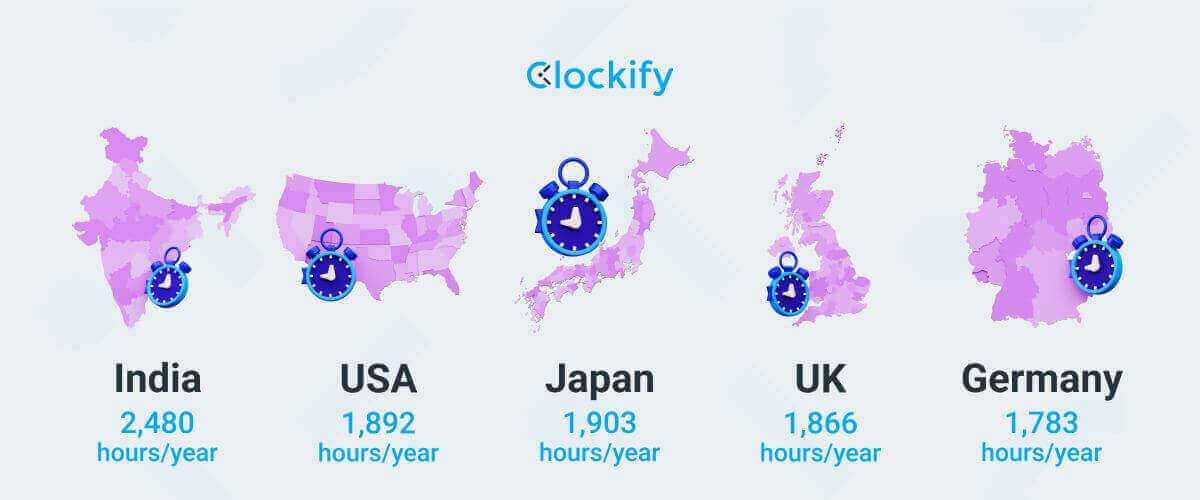
Working hours through history
Employees now work 20 to 30 hours less every week compared to the 19th century.
Average work hours in developed countries fell from 3,000 hours per year in 1870 to between 1,500 and 2,000 hours per year by 1990.
But this long-term decline in average annual work hours has slowed down in almost all countries around the world and occasionally reversed.
As a matter of fact, the work time in primitive hunter-gatherer societies was much lower than in modern agricultural societies. Compared to prehistoric people, who worked 1,773 hours per year on average, modern farmers spent 1,980 hours per year working.
| Period | Work hours |
|---|---|
| Prehistoric (hunter-gatherer societies) | 1,773 hours/year |
| 13th century (adult male peasant, UK) | 1,620 hours/year |
| 14th century (casual laborer, UK) | 1,440 hours/year |
| Middle ages (English worker) | 2,309 hours/year |
| 1400-1600 (farmer-miner, adult male, UK) | 1,980 hours/year |
| 1840 (average worker, UK) | 3,105-3,588 hours/year |
| 1850 (average worker, US) | 3,150-3,650 hours/year |
| 1987 (average worker, US) | 1,949 hours/year |
| 1988 (manufacturing workers, UK) | 1,856 hours/year |
| 2022 (average worker, US) | 1,892 hours/year |
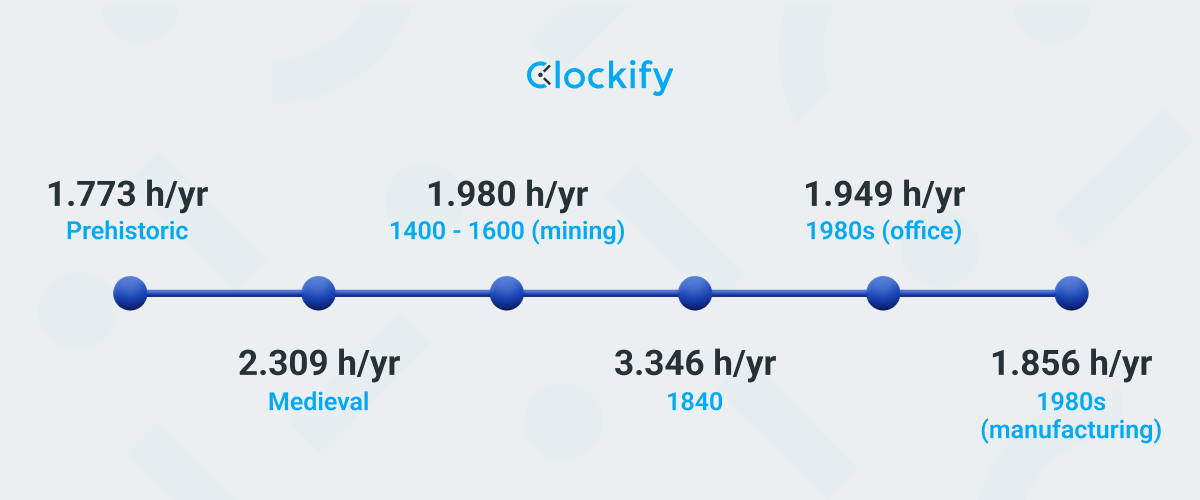
Even though the Industrial Revolution brought about long working hours, immediately after the size of the labor force expanded in the 1980s, average working hours significantly reduced.
As time went on and the industries progressed, the working hours continued to drop. So, by looking at 2020, we can spot a significant decline in annual working hours compared to the time employees spent working in 1980.
The graph below shows that the most drastic reduction in working hours happened in Germany, where workers spent 39% less time working in 2020 than in 1980.
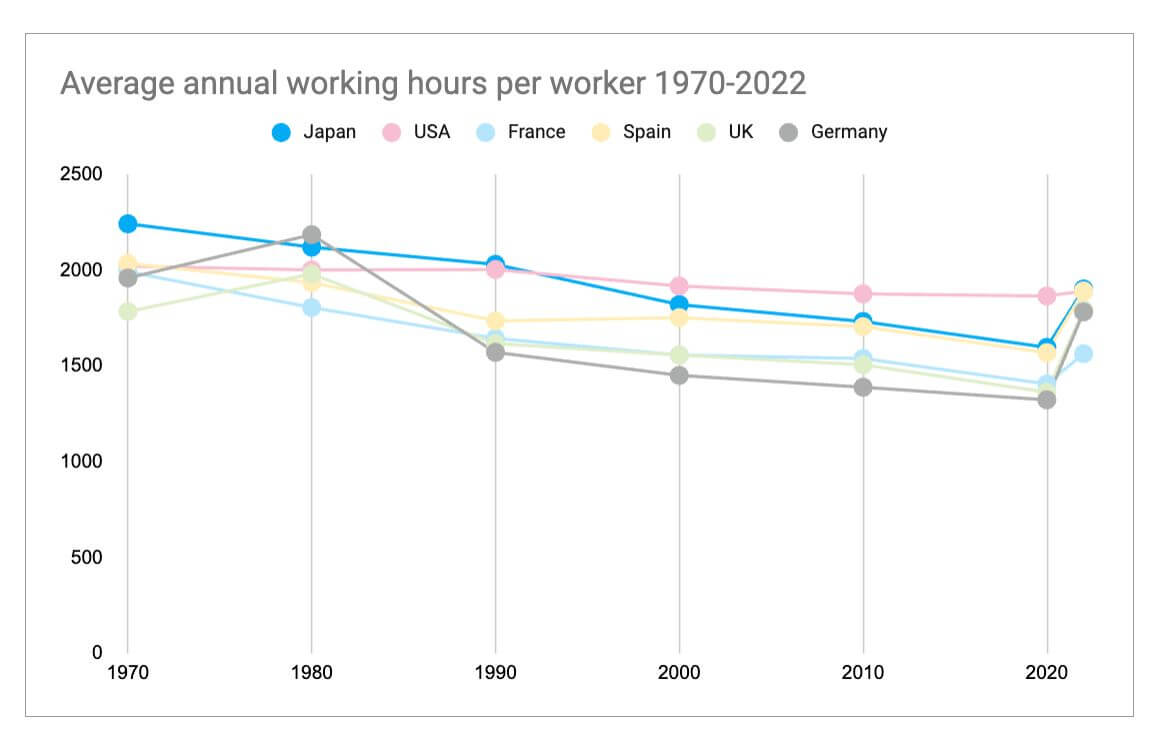
In 2022, however, the average annual working hours increased compared to 2020, but they were still lower compared to 1980.
Workers in Japan, for example, spent 1,598 hours per year working in 2020, whereas in 2022, they spent 1,892 hours per year at work.
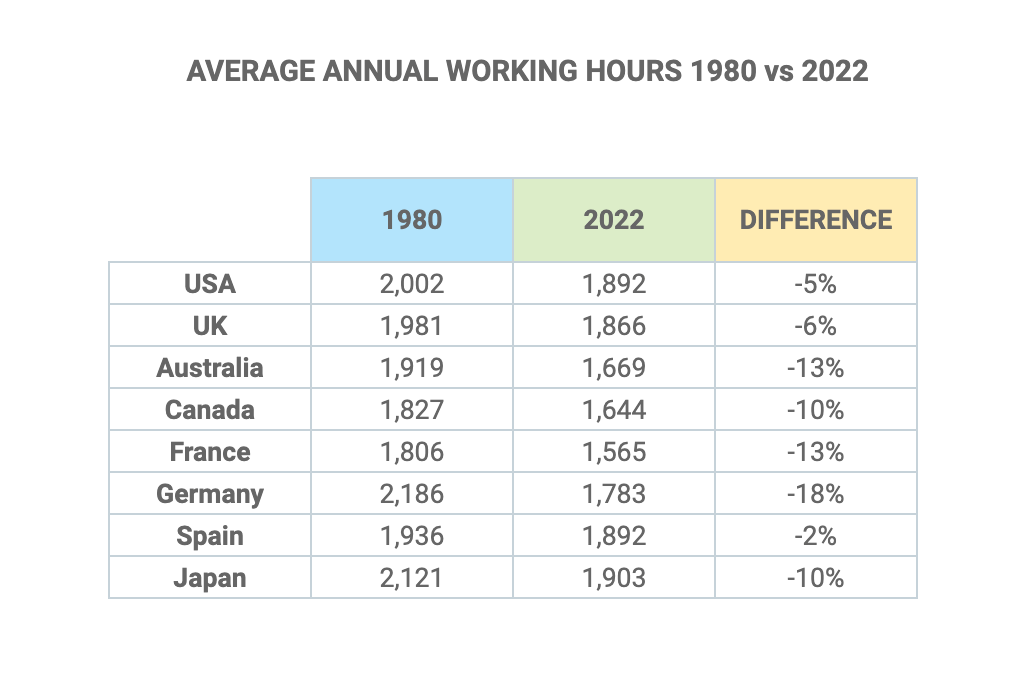
An average German worker, on the other hand, spent:
- 2,186 hours per year working in 1980,
- 1,324 h/year in 2020, and
- 1,783 h/year in 2022.
Working hours by country
Even though employees today spend drastically less time working than they did during the Industrial revolution — their average annual working hours significantly differ, depending on the country they live in.
Take a look at the table below for more information on the average annual working hours per employee in countries around the world. The hours worked per year are listed in ascending order.
Annual working hours per employee (worldwide)
| Uruguay | 1,284 h |
| Rwanda | 1,456 h |
| Austria | 1,534 h |
| Ethiopia | 1,549 h |
| Iraq | 1,560 h |
| Somalia | 1,565 h |
| France | 1,565 h |
| The Netherlands | 1,627 h |
| Australia | 1,669 h |
| Canada | 1,669 h |
| Cyprus | 1,716 h |
| New Zealand | 1,716 h |
| Madagascar | 1,731 h |
| Slovakia | 1,736 h |
| Norway | 1,742 h |
| Czech Republic | 1,768 h |
| Denmark | 1,768 h |
| Ghana | 1,768 h |
| Azerbaijan | 1,768 h |
| Solomon Islands | 1,768 h |
| Timor-Leste | 1,768 h |
| Germany | 1,783 h |
| Switzerland | 1,788 h |
| Kyrgyzstan | 1,788 h |
| Ecuador | 1,794 h |
| Panama | 1,794 h |
| Argentina | 1,799 h |
| Hungary | 1,804 h |
| Finland | 1,814 h |
| Belgium | 1,820 h |
| Chad | 1,820 h |
| Israel | 1,820 h |
| Sweden | 1,830 h |
| Belarus | 1,846 h |
| Nicaragua | 1,851 h |
| United Kingdom | 1,866 h |
| Ireland | 1,872 h |
| Curacao | 1,872 h |
| Comoros | 1,872 h |
| Luxembourg | 1,872 h |
| Sri Lanka | 1,872 h |
| Italy | 1,877 h |
| United States | 1,892 h |
| Spain | 1,892 h |
| Iceland | 1,903 h |
| Japan | 1,903 h |
| Cook Islands | 1,924 h |
| Estonia | 1,924 h |
| Marshall Islands | 1,924 h |
| Peru | 1,939 h |
| North Macedonia | 1,960 h |
| Chile | 1,960 h |
| Russia | 1,965 h |
| South Korea | 1,970 h |
| Brazil | 1,970 h |
| Afghanistan | 1,970 h |
| Kazakhstan | 1,976 h |
| Nigeria | 1,976 h |
| Armenia | 1,976 h |
| Latvia | 1,976 h |
| Montserrat | 1,976 h |
| Portugal | 1,986 h |
| Croatia | 1,986 h |
| Bolivia | 2,002 h |
| Dominican Republic | 2,002 h |
| Lithuania | 2,012 h |
| Moldova | 2,012 h |
| Venezuela | 2,012 h |
| Zimbabwe | 2,012 h |
| Ukraine | 2,028 h |
| Aruba | 2,028 h |
| Angola | 2,028 h |
| Greece | 2,028 h |
| Belize | 2,028 h |
| Tanzania | 2,028 h |
| Mauritius | 2,028 h |
| Nauru | 2,028 h |
| Palau | 2,028 h |
| Saint Lucia | 2,028 h |
| The Philippines | 2,038 h |
| Indonesia | 2,043 h |
| Bulgaria | 2,054 h |
| Serbia | 2,059 h |
| Romania | 2,069 h |
| Ivory Coast | 2,080 h |
| Nepal | 2,080 h |
| Haiti | 2,080 h |
| Seychelles | 2,080 h |
| Yemen | 2,080 h |
| Poland | 2,085 h |
| Honduras | 2,090 h |
| Burundi | 2,095 h |
| Benin | 2,100 h |
| Thailand | 2,106 h |
| Georgia | 2,106 h |
| Slovenia | 2,017 h |
| Costa Rica | 2,132 h |
| Paraguay | 2,132 h |
| Bermuda | 2,132 h |
| Jamaica | 2,132 h |
| Tajikistan | 2,132 h |
| Vietnam | 2,132 h |
| Albania | 2,142 h |
| Zambia | 2,147 h |
| Bosnia | 2,173 h |
| Uganda | 2,173 h |
| Mali | 2,178 h |
| Laos | 2,184 h |
| South Africa | 2,184 h |
| Cayman Islands | 2,184 h |
| Malta | 2,184 h |
| Singapore | 2,184 h |
| Sierra Leone | 2,199 h |
| Guyana | 2,210 h |
| Montenegro | 2,220 h |
| Mexico | 2,220 h |
| Botswana | 2,227 h |
| Falkland Islands | 2,228 h |
| El Salvador | 2,236 h |
| Eswatini | 2,236 h |
| Egypt | 2,236 h |
| Saudi Arabia | 2,236 h |
| Namibia | 2,241 h |
| Malaysia | 2,246 h |
| Guatemala | 2,251 h |
| Colombia | 2,256 h |
| Turkey | 2,256 h |
| Algeria | 2,272 h |
| Iran | 2,282 h |
| Togo | 2,288 h |
| Mozambique | 2,288 h |
| Samoa | 2,288 h |
| Senegal | 2,314 h |
| Myanmar | 2,319 h |
| Morocco | 2,340 h |
| Burkina Faso | 2,345 h |
| Kenya | 2,350 h |
| Mongolia | 2,355 h |
| Cambodia | 2,360 h |
| China | 2,392 h |
| Tunisia | 2,392 h |
| Brunei Darussalam | 2,392 h |
| Lebanon | 2,392 h |
| Maldives | 2,392 h |
| Jordan | 2,423 h |
| Pakistan | 2,428 h |
| Bangladesh | 2,438 h |
| Liberia | 2,454 h |
| Mauritania | 2,470 h |
| India | 2,480 h |
| Qatar | 2,496 h |
| Lesotho | 2,548 h |
| DR Congo | 2,572 h |
| Gambia | 2,600 h |
| Bhutan | 2,636 h |
| United Arab Emirates | 2,704 h |
*The average annual working hours provided in the table are the average weekly hours provided by the International Labour Organization multiplied by 52.
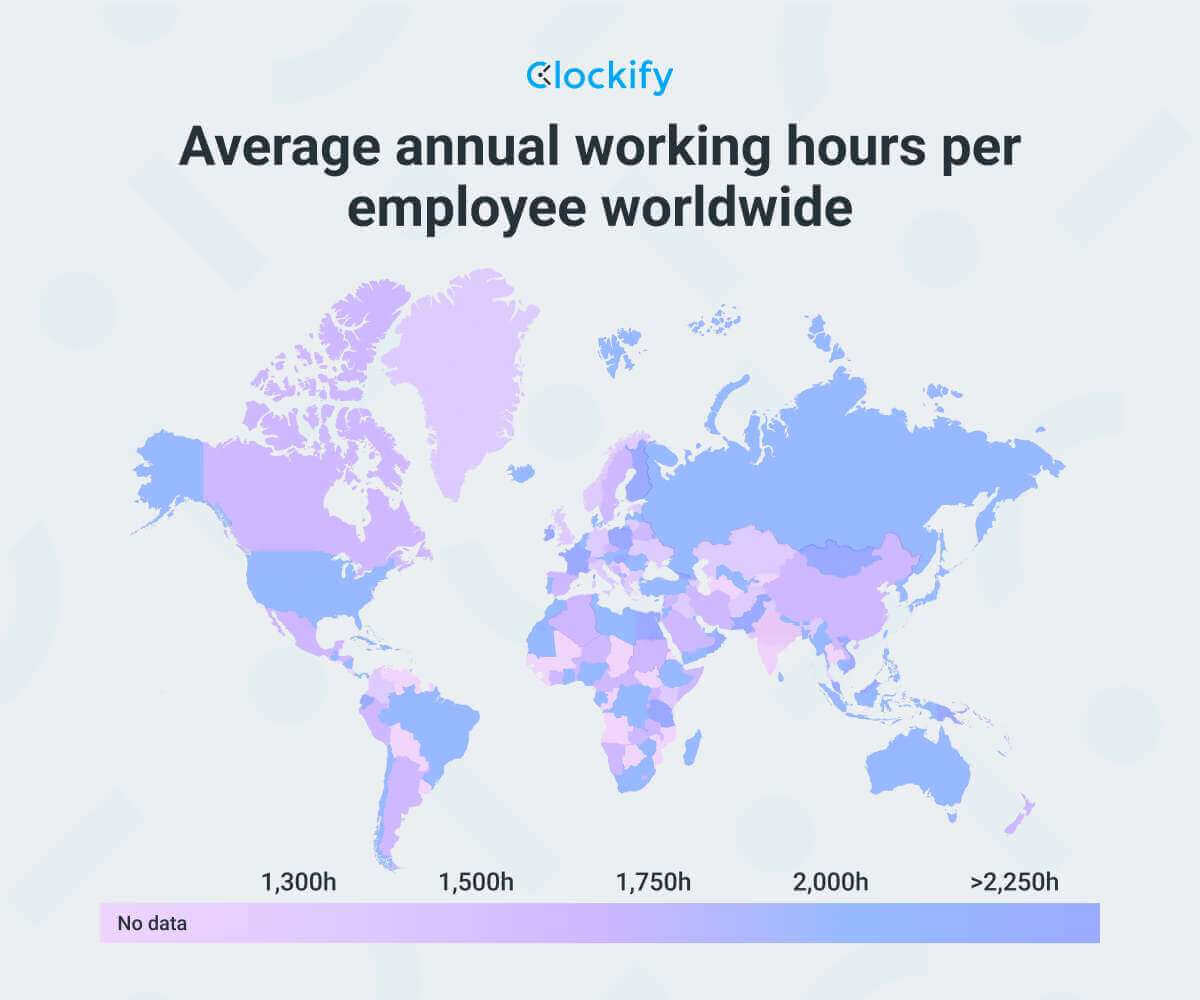
So, for example, while employees in Turkey spend 2,256 hours a year at work, workers from the Netherlands work less than 1,627 hours per year.
Let’s take a closer look at how working hours differ across the world by going over:
- Working hours in OECD countries,
- Working hours in the EU,
- Working hours in the UK,
- Working hours in Germany, and
- Working hours in the US.
Working hours in OECD countries
On average, a full-time employee in an OECD country works 36 hours per week.
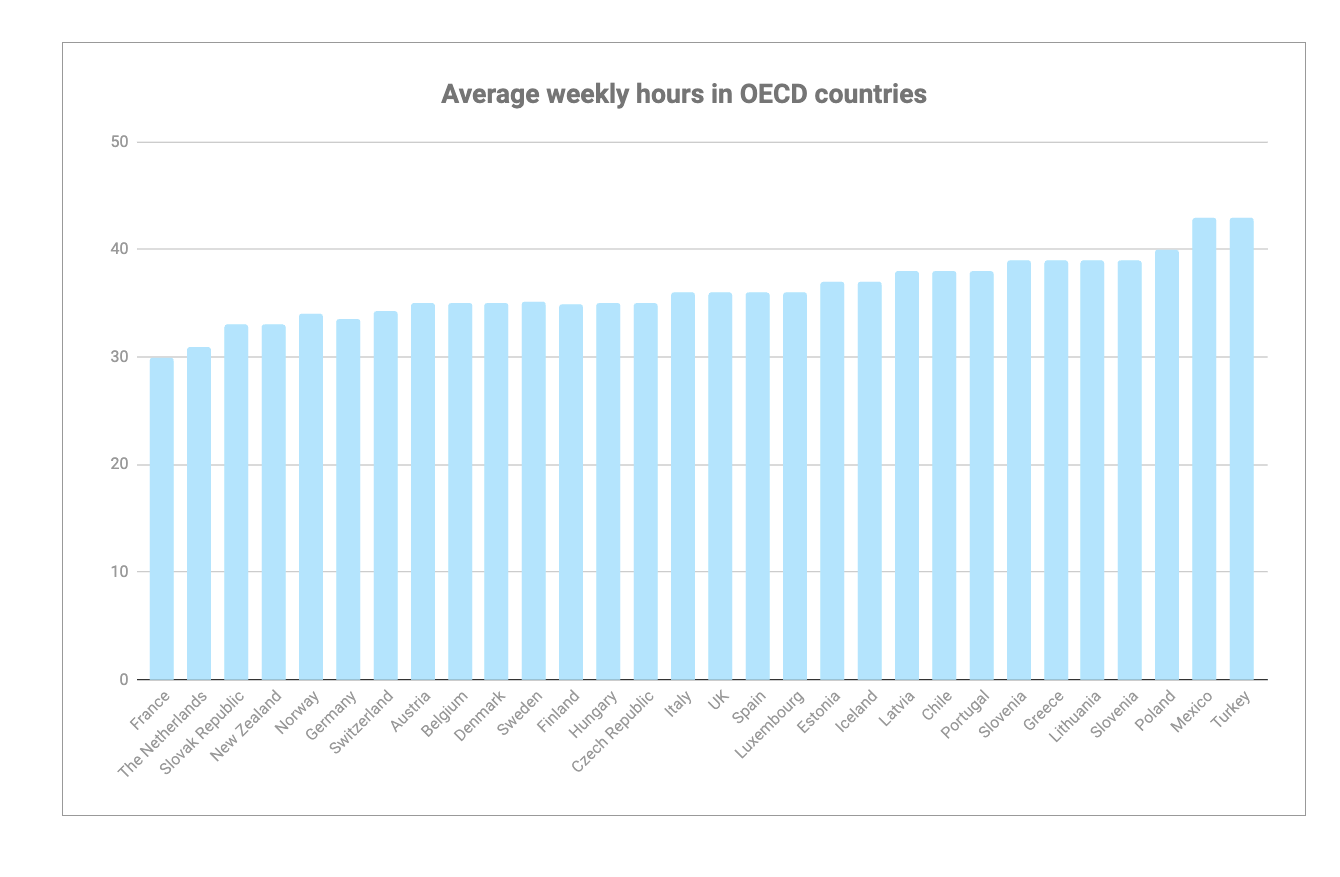
This translates to an average of 1,854 working hours per year, out of which workers in Austria spent the least amount of time at work (1,534 hours per year), whereas an average employee in Mexico spent 2,220 hours working in 2022.
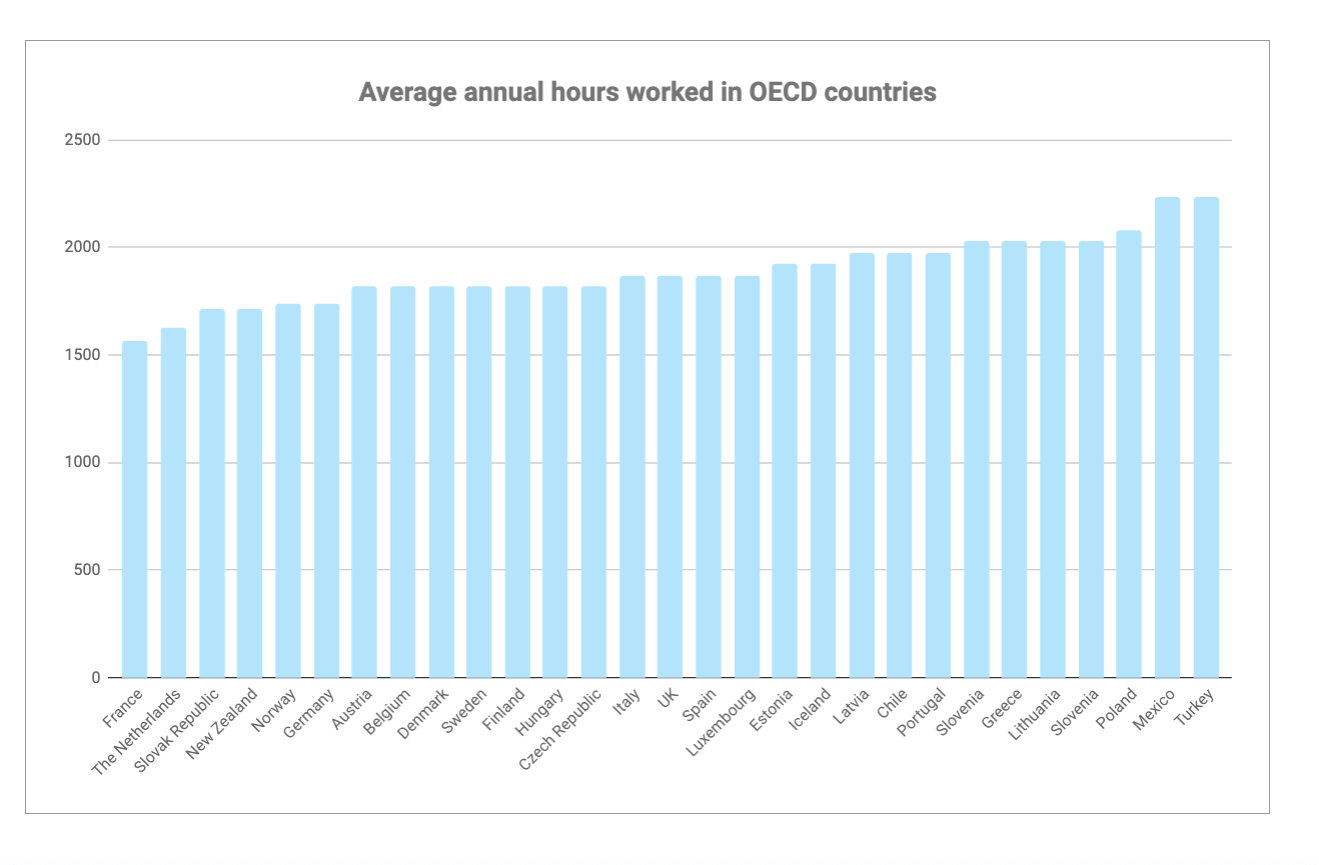
Working hours in EU
On the other hand, an average full-time employee in the European Union works 36 hours per week (main job).
In 2022, the longest working hours were reported in Turkey — 43 hours per week, while employees spent the least time working in the Netherlands — 31 hours per week.
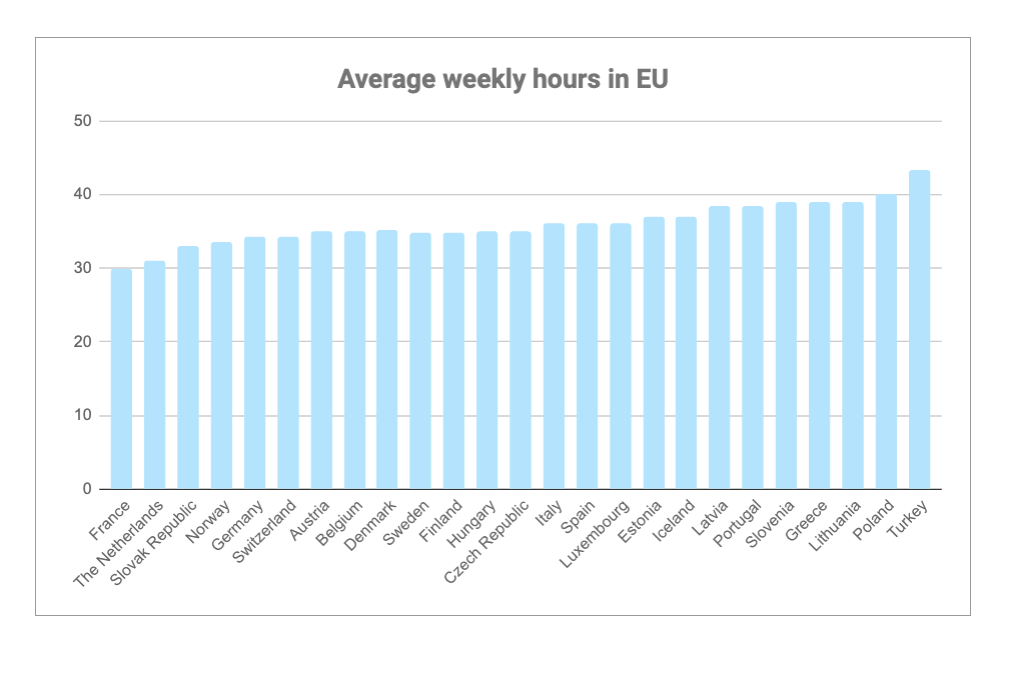
By EU labor law, working hours are limited to 48 hours per week, including overtime (if permitted by national law, you may have an agreement with a staff member to work beyond the 48-hour limit).
Mandatory overtime: What you need to knowWorking hours in UK
On average, a full-time employee in the United Kingdom works 1,866 hours per year or 35.9 hours per week.
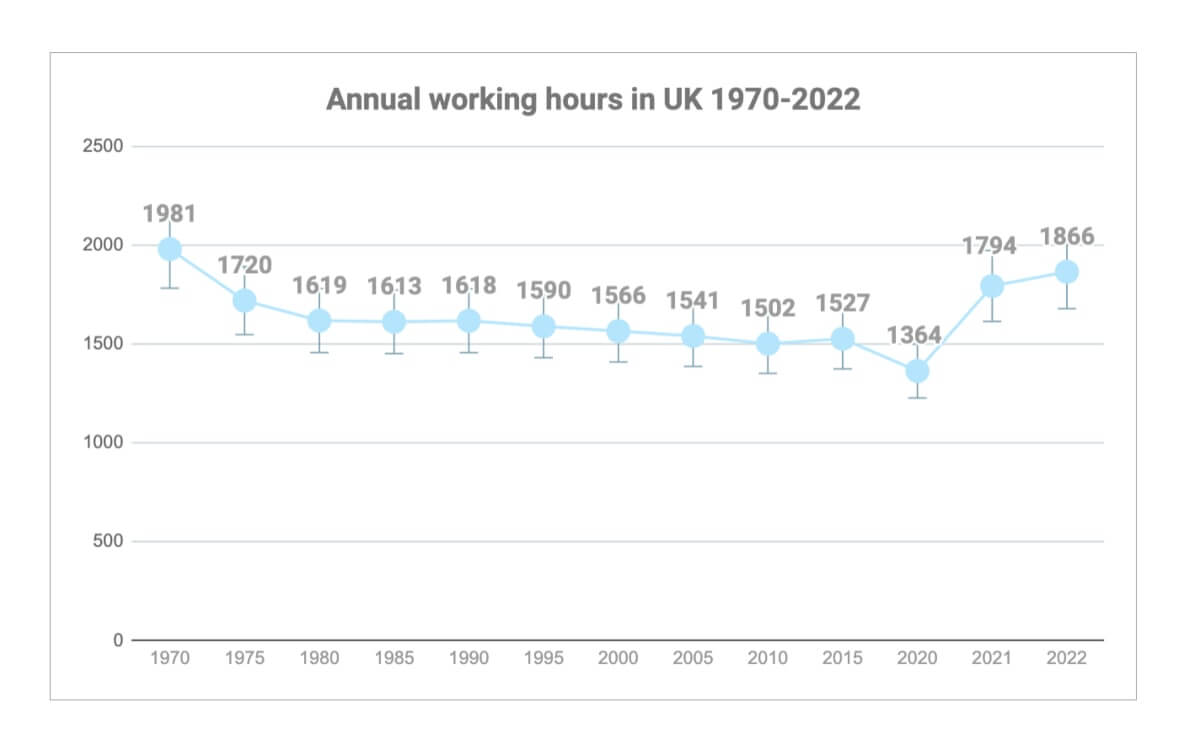
Working hours in Germany
When it comes to Germany, a full-time employee works 1,783 hours per year or 34.3 hours per week on average.
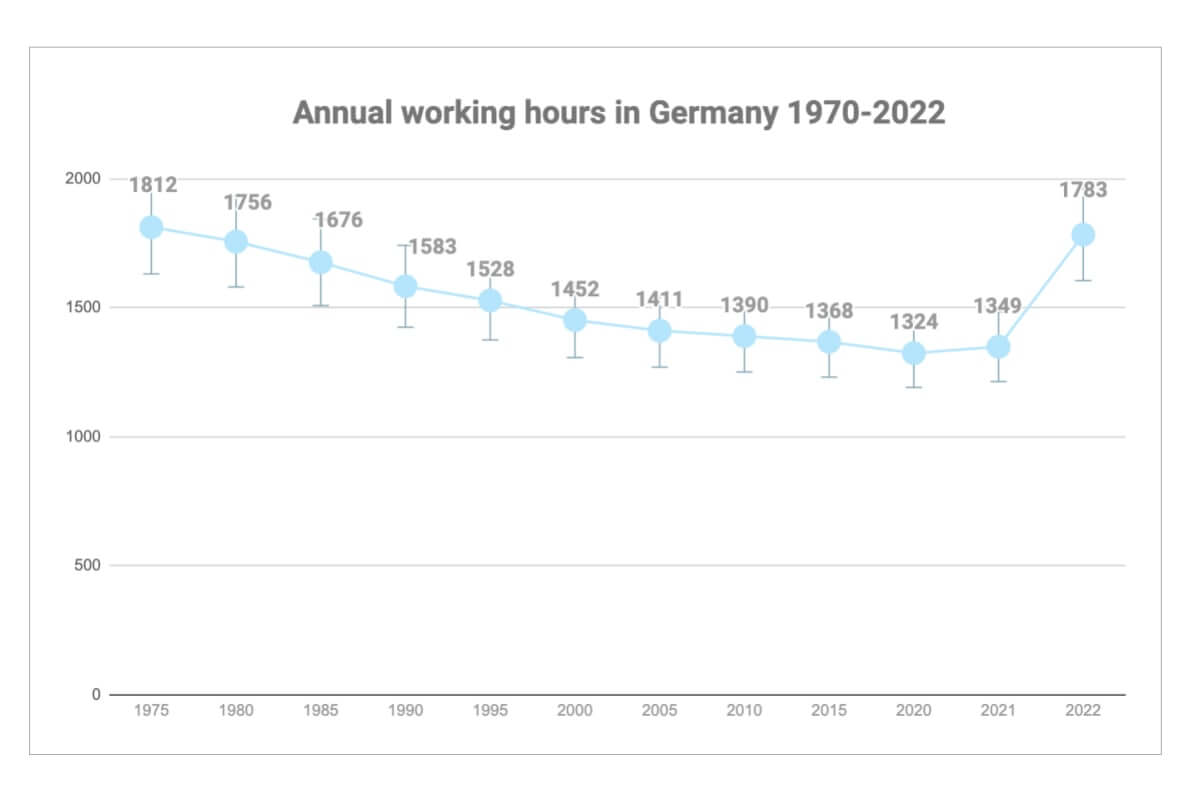
Working hours in US
A full-time employee in the United States works 1,892 hours per year, or 36.4 hours per week, which is slightly more than other OECD countries.
On average, employees from the US work around 10 hours per year more than workers from the EU.
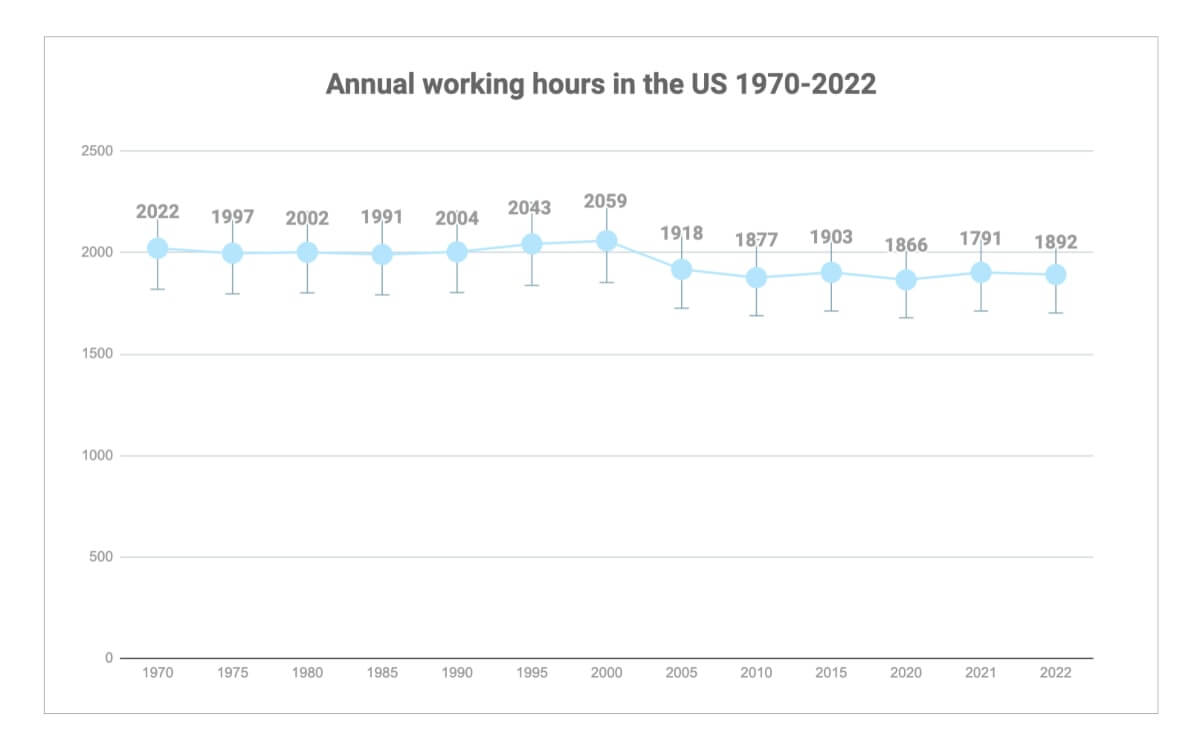
Working hours by industry in the US
According to the most recent US Bureau of Labor Statistics data, employees working in the mining and logging industry in the US worked the longest hours — 45.5 hours per week on average in April 2023.
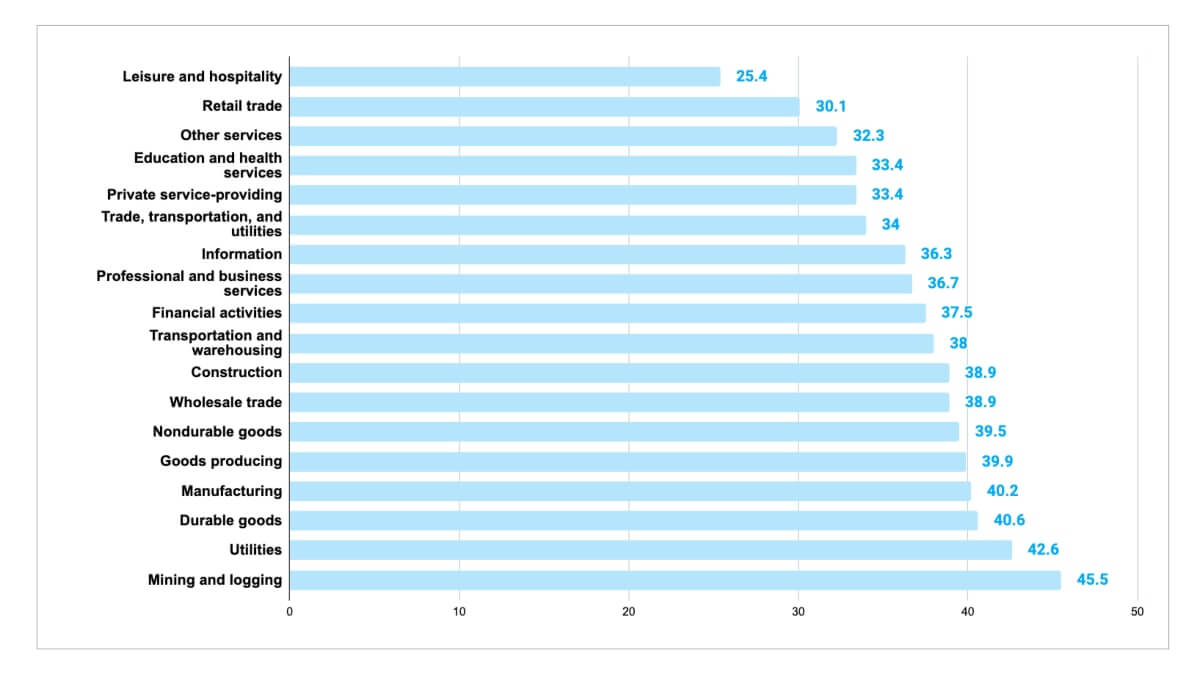
On the other hand, leisure and hospitality workers in the US have the least working hours — 25.4 hours per week in April 2023.
Annual working hours by city
Average annual working hours do not only vary from country to country, but they can also be different depending on the city of employment.
Here are some of the most recent annual working hours in 40 different cities across the world:
Annual working hours by city
| Copenhagen | 1,380 h |
| Oslo | 1,384 h |
| Berlin | 1,386 h |
| Amsterdam | 1,440 h |
| Reykjavik | 1,454 h |
| Paris | 1,505 h |
| Zurich | 1,556 h |
| Brussels | 1,586 h |
| Ljubljana | 1,593 h |
| Stockholm | 1,605 h |
| Buenos Aires | 1,609 h |
| Vienna | 1,611 h |
| London | 1,668 h |
| Barcelona | 1,686 h |
| Ottawa | 1,689 h |
| Tokyo | 1,691 h |
| São Paulo | 1,707 h |
| Rome | 1,717 h |
| Sydney | 1,726 h |
| New York | 1,765 h |
| Dublin | 1,772 h |
| Auckland | 1,779 h |
| Prague | 1,787 h |
| Bucharest | 1,792 h |
| Istanbul | 1,832 h |
| Faro | 1,865 h |
| Tel Aviv | 1,900 h |
| Santiago | 1,914 h |
| Medellin | 1,968 h |
| Jakarta | 2,020 h |
| Warsaw | 2,022 h |
| Athens | 2,036 h |
| San Jose | 2,069 h |
| Taipei | 2,085 h |
| Bangkok | 2,093 h |
| Delhi | 2,123 h |
| Mexico City | 2,137 h |
| Lima | 2,140 h |
| Hong Kong | 2,147 h |
| Singapore | 2,330 h |
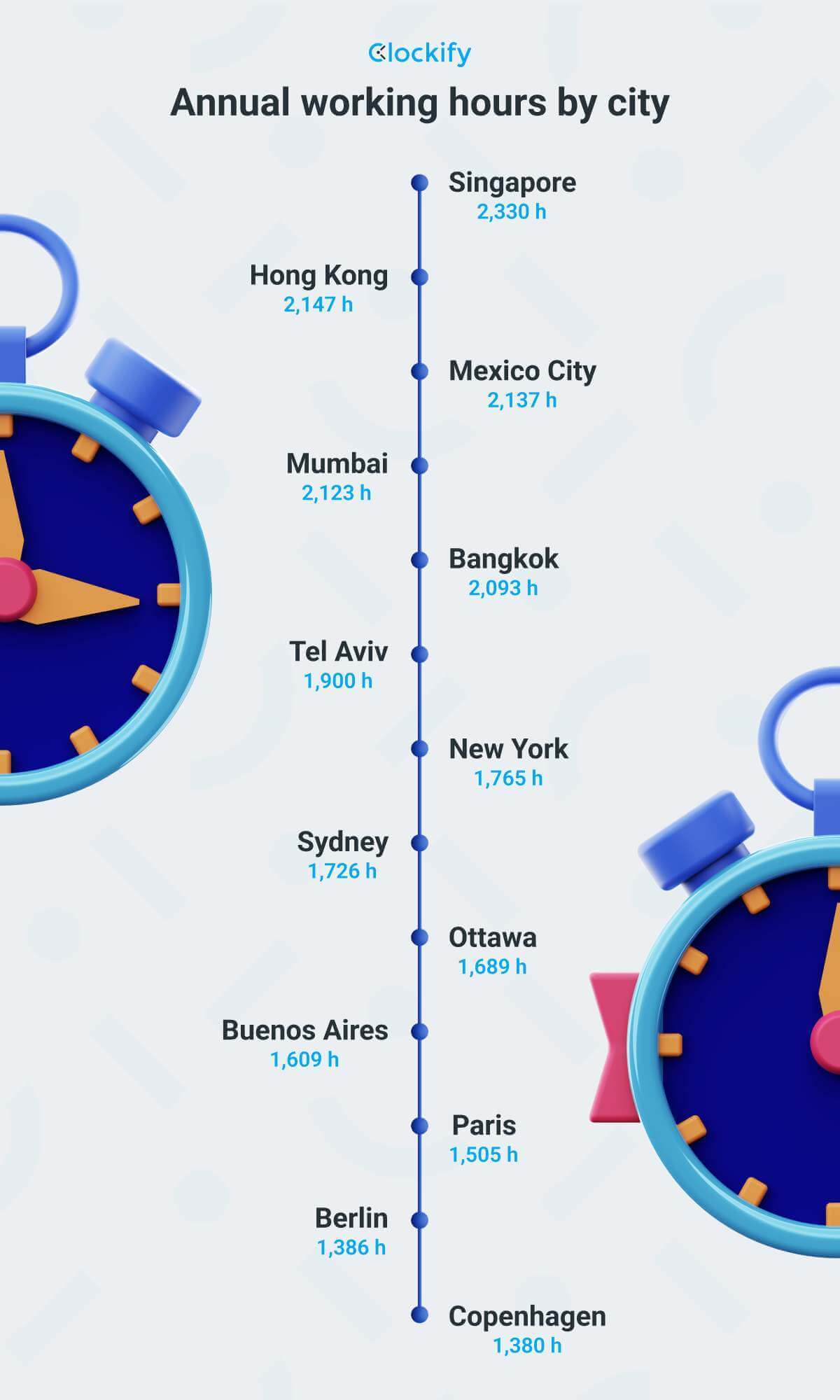
Employees from Copenhagen, for example, spend the least time at work compared to the rest of the mentioned cities — only 1,380 hours per year.
On the other hand, Singapore workers work almost twice as much — they spend 2,330 hours per year at work.
Weekdays and paid time-off by country
Workdays and weekends differ by country.
In most of the world, the workweek is from Monday to Friday. However, in Muslim-majority countries, the usual workweek is from Sunday to Thursday.
Also, some countries work six days per week, while some, such as Australia and Sweden for example, have adopted a 4-day workweek.
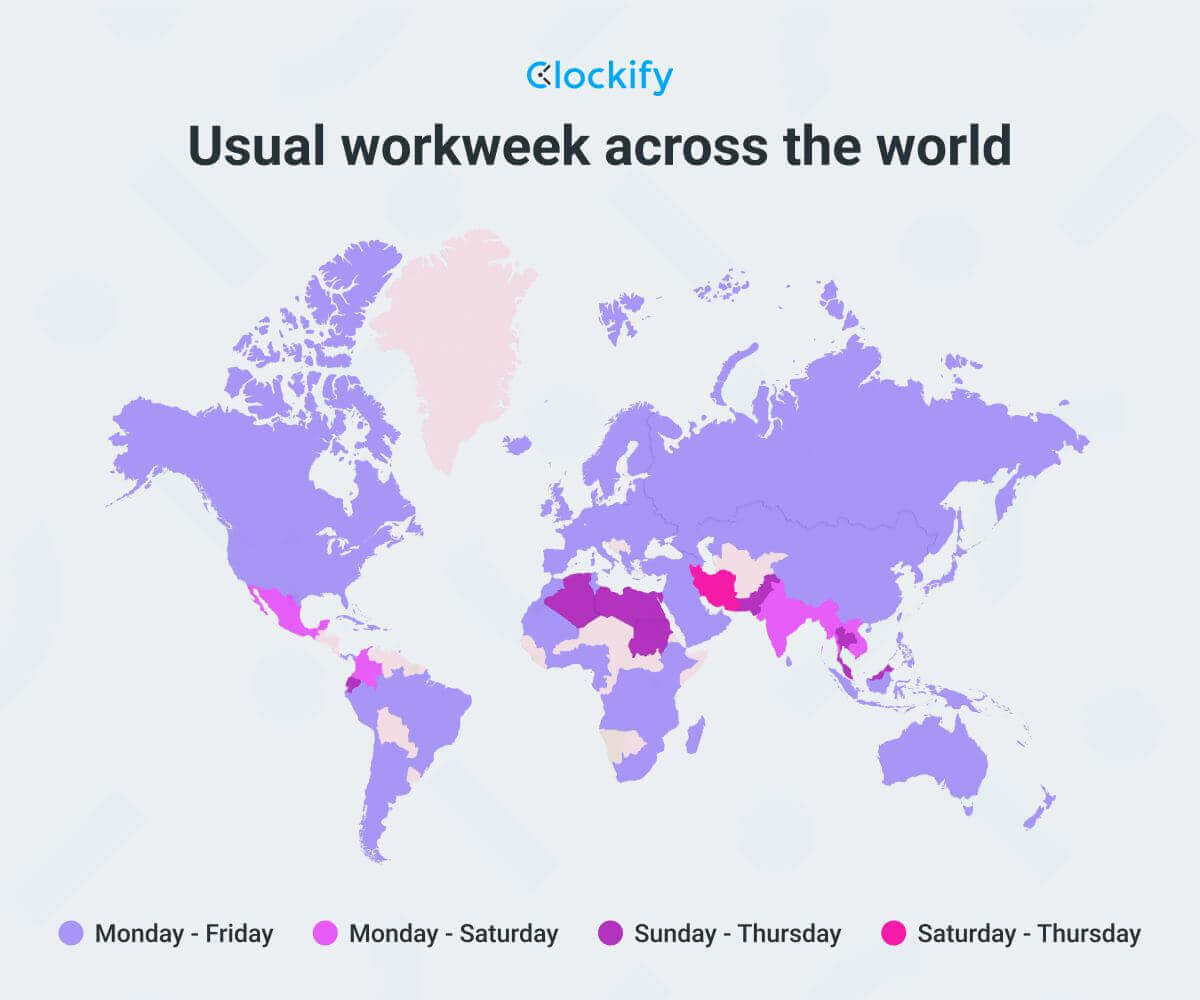
Most countries in the world have laws setting the maximum length of the workweek and the paid vacation minimum, except for the United States.
The US is the only industrialized country in the world that doesn’t have legally mandated annual leave and does not guarantee its workers paid vacation.
State Labor Law GuidesEuropean countries, on the other hand, mandate a minimum of at least 20 paid vacation days per year (some even go higher to 25 or even 30 or more days).
Australia and New Zealand require employers to grant at least 20 vacation days per year, and Canada and Japan mandate at least 10 paid days off.
In addition to mandated paid annual leave, workers also get paid time off for public holidays.
For instance, the FLSA does not require private US employers to offer paid holidays to their employees, but most of the rest of the world's developed countries offer at least 6 paid holidays per year (while some countries like Cambodia and Iran offer 27 paid holidays).
What are paid holidays and how do they work?In the absence of government standards, 28 million Americans don’t have any vacation or paid holidays. According to the US Bureau of Labor Statistics, the average US worker receives only about 10 days of paid vacation and about 6 paid holidays per year — less than the minimum legal standard set in the rest of the world's rich economies.
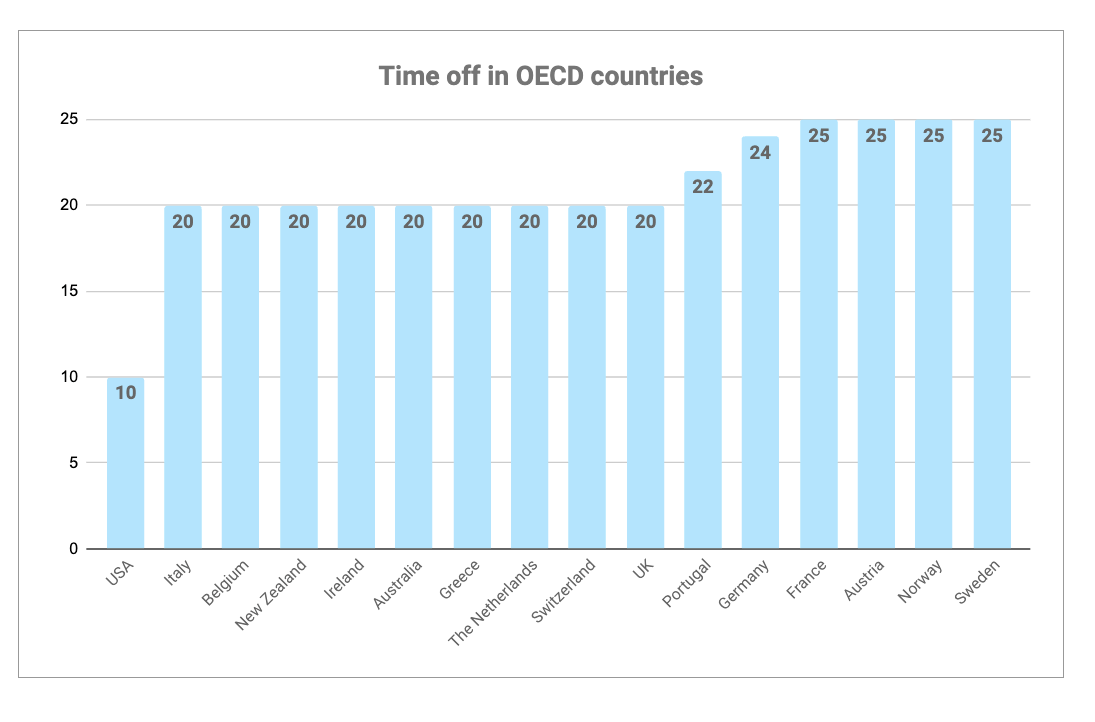
Productivity and working overtime
A longer working week does not necessarily result in higher levels of productivity.
For example, workers in Mexico have quite long annual shifts (2,220 hours/year), but their GDP per hour is among the lowest.
As productivity increases, working hours decrease. For example, employees in Ireland work 36 hours per week on average (1,872 hours/year), but their GDP per hour is the highest in the world.
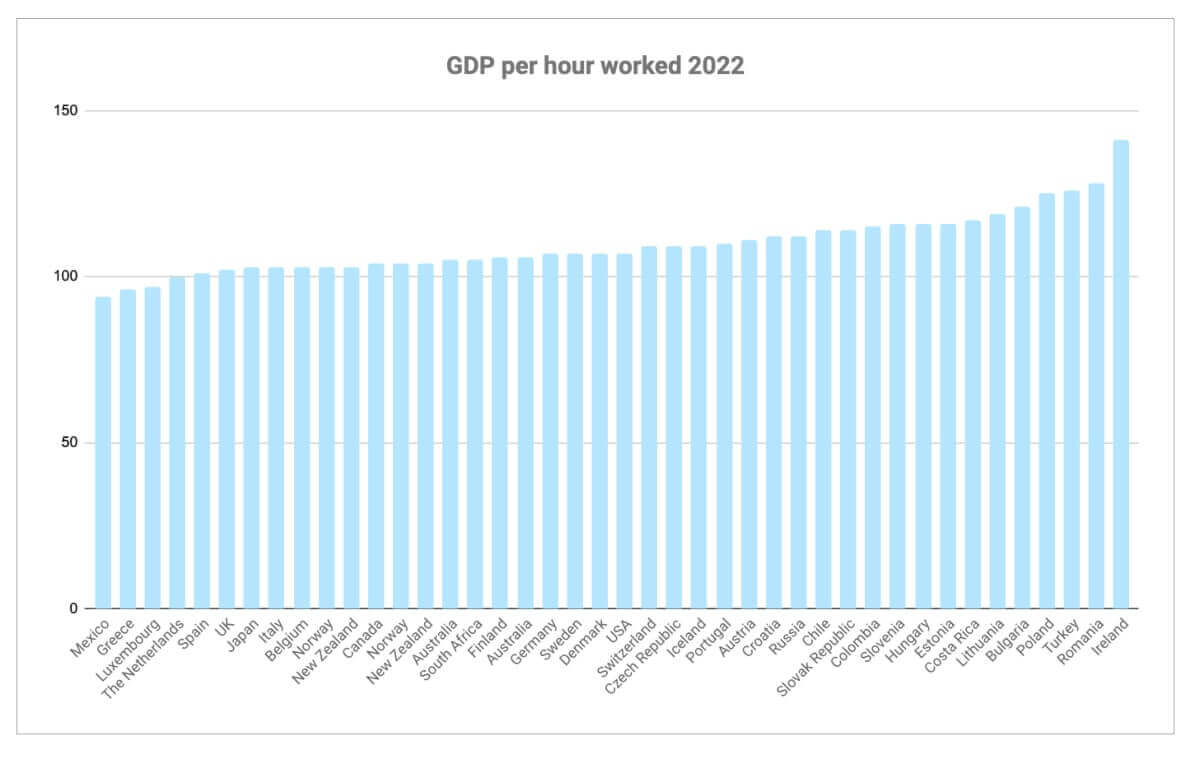
However, productivity levels have not always been as high as today. In fact, productivity has been increasing exponentially for more than a century.
Therefore, an average worker today must work 11h per week to produce as much as the one working 40h per week in 1950.
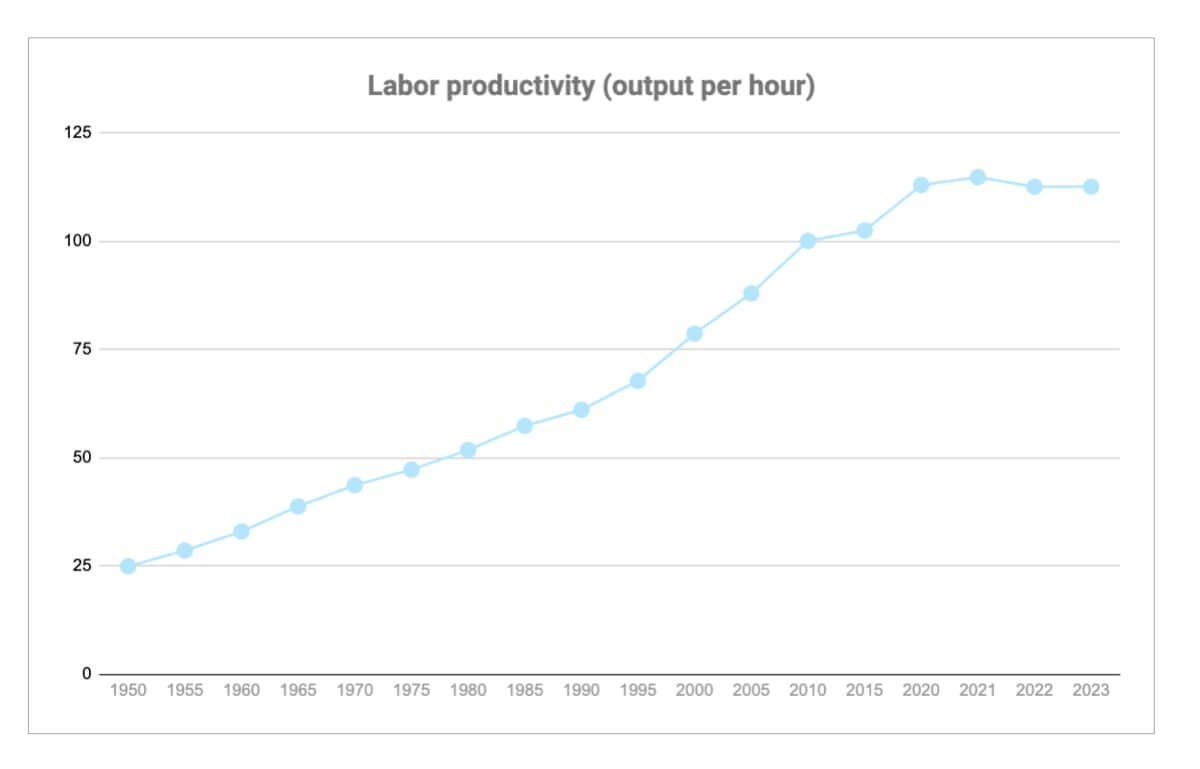
But, fast productivity growth has not necessarily reduced work time.
Namely, even though overtime is legally regulated in most countries by a combination of laws, research has shown that one in ten employees worked an extra day of unpaid overtime every week in 2021.
Overtime Calculator | Should I work overtime without pay?However, due to long hours and a high burnout rate, workers across America demonstrated a 4.1% drop in productivity in 2022. This is the lowest drop ever since the US Bureau of Labor Statistics started measuring employee productivity in 1948.
The negative productivity trend continued in 2023 — the US workers’ productivity dropped by 2.7% in the first quarter of 2023.
Career burnout and its effect on health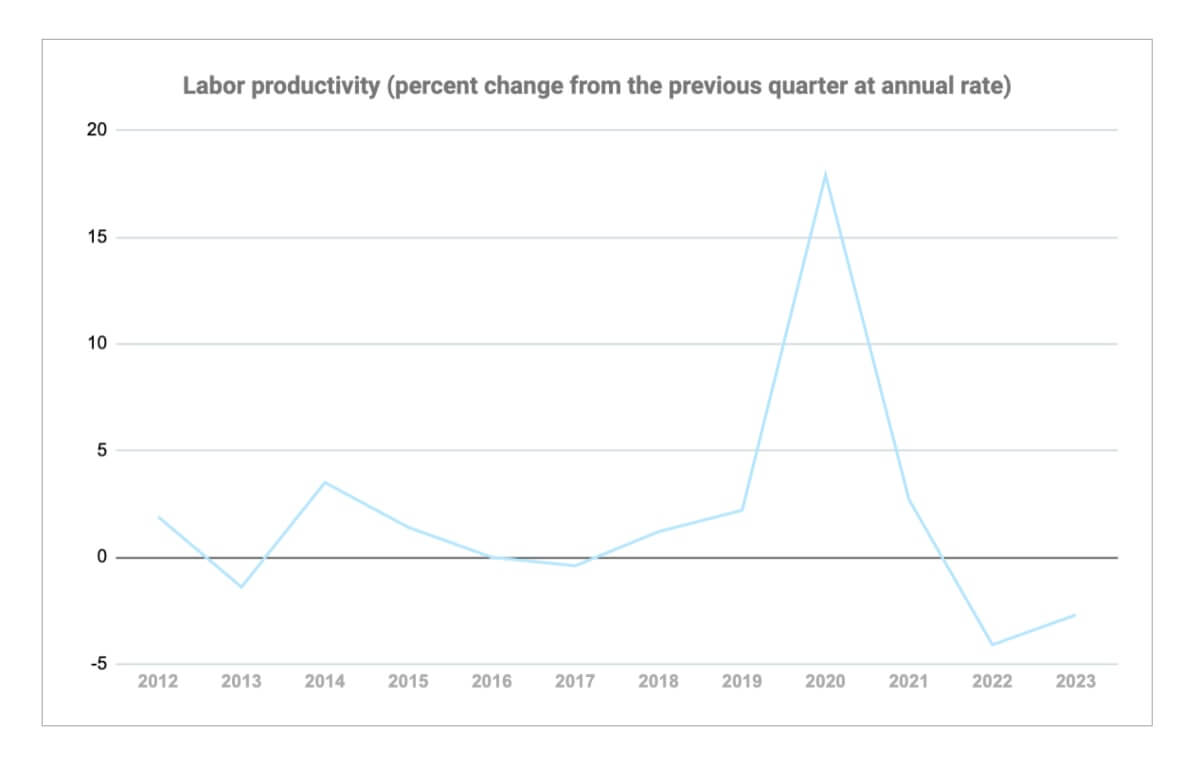
Quiet quitting and its impact on employee engagement
Given that there’s a strong link between employee productivity, performance outcomes, and engagement, an increased number of actively disengaged employees (from 13% to 18%) could mean quiet quitting is on the rise.

Since quiet quitting involves employees completing their core tasks while refusing to sacrifice their private life to go above and beyond at work, a decline in productivity and output shouldn’t come as a surprise.
As most jobs require going the extra mile to collaborate with team members (especially in a remote or a hybrid setting), a productivity drop seems like a logical outcome of more than 50% of US employees embracing the quiet quitting phenomenon.
8 fast ways to increase employee productivity in the workplaceConclusion: The future of working hours remains to be seen
Even though working hours vary across countries, they have been exponentially decreasing over centuries in every corner of the world.
Compared to an average 1850s worker who used to work more than 3,000 hours per year, a 2023 employee spends 1,892 hours at work.
Still, although this change has increased employee productivity, the number of actively disengaged workers who decided to quit quietly has risen too.
Whether the quiet quitting trend will continue to rise, or we’ll soon witness a further decrease in working hours, remains to be seen in the years to come.
*The average working hours in this guide are the average weekly hours provided by the International Labour Organization multiplied by 52.
Sources
- Hours worked — OECD Data
- GDP per hour worked — OECD Data
- Working Hours — Our World in Data
- Is Paid Annual Leave Available to All Workers — World Policy Center
- Is Quiet Quitting Real — Gallup
- State of the Global Workplace: 2022 Report — Gallup
- Labor productivity — U.S. Bureau of Labor Statistics
- The Cities In The World With The Best Work/Life Balance — Holidu
- People at Work 2022: A Global Workforce View — ADP Research
- Employee Benefits Survey — U.S. Bureau of Labor Statistics
- Average usual weekly hours worked on the main job — OECD Stat
- Weekly average working hours —- Statista
- Trend in working hours — OECD Library
- List of minimum annual leave by country — Wikipedia
- Workweek and weekend — Wikipedia
- Pre-industrial workers had a shorter workweek than today's — MIT Edu
- Diminishing Returns at Work: The Consequences of Long Working Hours
- Are we working more than ever? — Our World in Data
- Average usual weekly hours worked on the main job — OECD Stat
- Hours of work - annual statistics — Eurostat Statistics Explained
- Average weekly hours and overtime of all employees on private nonfarm payrolls by industry sector, seasonally adjusted — U.S. Bureau of Labor Statistics
- Statistics on Working Time — International Labour Organization
- Average Workweek by Country 2023 — World Population Review
- The 1980’s: a decade of job growth and industry shifts — U.S. Bureau of Labor Statistics